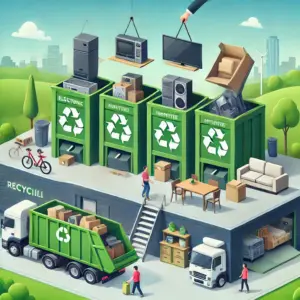Key Takeaways:
Disposing large household items responsibly is essential to minimize environmental impact and promote sustainability. By recycling, donating, engaging with local waste services, and understanding proper disposal methods, you can ensure these items are handled eco-friendly. Following structured steps aids in effectively clearing space while being environmentally considerate.
Table of Contents:
- Introduction
- Understanding the Importance of Responsible Disposal
- Planning and Organizing for Disposal
- Exploring Disposal Options
- Donating and Selling Large Items
- Recycling and Waste Management
- Engaging Professional Services
- Understanding Local Regulations
- Conclusion
Introduction
In a world increasingly conscious of environmental sustainability, responsibly disposing of large household items becomes critical. These items, from old furniture to obsolete appliances, present unique challenges due to their size and components. This guide will discuss practical methods for responsibly disposing of large household items while considering environmental impacts. From donation and resale to recycling and professional services, there are numerous ways to manage unwanted items that benefit your living space and the environment.

Understanding the Importance of Responsible Disposal
Disposing of large household items responsibly carries significant ecological and social importance. Incorrect disposal practices can contribute to environmental degradation, including pollution and resource wastage. Many of these items contain materials that, when improperly handled, release toxins into the environment. Moreover, reuse and recycling conserve resources and reduce landfill pressure. Responsible disposal also offers an opportunity to give back to the community through donations or second-hand giveaways. Engaging with sustainable practices helps create a circular economy, supporting the planet and society.
Planning and Organizing for Disposal
Proper planning and organization are vital before initiating the disposal process. Start by evaluating the items you wish to dispose of, considering size, condition, and potential for reuse or recycling. Create a list and categorize items based on their material type and disposal options. Items in good condition can often be resold or donated, while broken items may need specialized recycling services. Scheduling time for the disposal process ensures an organized approach, preventing further clutter and stress. Researching options beforehand will provide a roadmap, making it easier to proceed with sustainable choices.
Exploring Disposal Options
Once organized, explore the various disposal options available for large household items. Local waste services provide curbside pickup for bulk items, often as part of municipal programs. Services like local junk pickup can assist in hauling away items conveniently and responsibly. Always check for specific guidelines or requirements for item preparation, such as dismantling or hazardous material handling. Consider municipal waste drop-off centers that accept bulk items for a fee or as part of community cleanup events. Exploring these options broadens your scope for effective and eco-friendly disposal.
Donating usable furniture or appliances to local charities or shelters can give items a second life while helping those in need. Many nonprofit organizations offer free pickup services, making donations a hassle-free alternative to disposal. Recycling centers may accept materials like metal, wood, or electronics, reducing landfill waste and promoting sustainability. Some manufacturers or retailers provide take-back programs for old appliances or furniture when purchasing a replacement. Selling or giving away large items through online marketplaces or community groups can also be an efficient way to clear space while benefiting others.
Donating and Selling Large Items
Donating and selling are excellent methods for giving new life to large household items. Numerous charities and thrift stores accept furniture and appliance donations, repurposing them for community use. Ensure items are in good working condition and clean before donating. Some organizations even offer free pickup services. Online marketplaces and local swap groups provide platforms to sell large items, potentially recouping some costs while preventing waste. When selling or donating, include detailed descriptions and clear photos to attract interested parties. This approach aids in passing on items to those who may benefit from them.
Recycling and Waste Management
Recycling is paramount when disposing of large household items, particularly those containing metals, plastics, or electronic components. Contact local waste management facilities to learn about recycling programs, which often include drop-off points for appliances and electronics. Specialized recyclers deal with items like mattresses or large electronics, safely extracting recyclable materials and disposing of surrounding parts. Understanding the recycling processes available in your area helps you to be conscious of the disposal of such items. Management facilities also provide information on safely handling hazardous materials found in certain appliances, ensuring compliance with environmental safety standards.
Engaging Professional Services
Professional junk removal services offer a convenient solution when managing particularly difficult or bulk disposals. These companies specialize in handling large items, ensuring they are responsibly recycled, donated, or disposed of. Before hiring, research services to ensure their disposal methods align with environmental standards. Professional services benefit individuals without the means to transport large items or those seeking a hassle-free solution. They often provide full-service options, including retrieval, sorting, and delivery to donation centers or recycling facilities, streamlining the process and ensuring better environmental practices.
Understanding Local Regulations
Before disposing of large household items, familiarize yourself with local regulations regarding waste management. Cities and towns often have specific guidelines for bulk pick-up days, hazardous waste disposal, and recycling requirements. Understanding these regulations helps avoid fines and ensures that items are disposed of legally and sustainably. Inquire with local waste authorities to get accurate information on when and how different types of waste can be set out for collection. Compliance guarantees that items are handled appropriately and contributes to community-wide environmental efforts, reinforcing the shared responsibility towards sustainable living.
Conclusion
Disposing of large household items responsibly involves a series of informed decisions to reduce environmental impacts and support sustainable practices. Whether through donation, resale, recycling, or waste management services, each method contributes to a cleaner, healthier planet. By planning, understanding available resources, and adhering to local regulations, households can manage their clutter efficiently and ethically. Emphasizing responsible disposal methods supports a circular economy and reflects a commitment to sustainability that benefits current and future generations, promoting overall well-being and environmental stewardship.




Leave a Reply